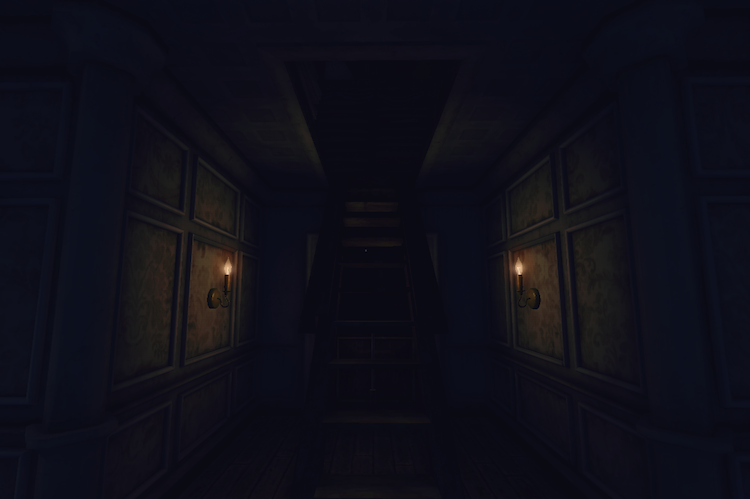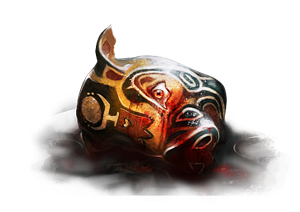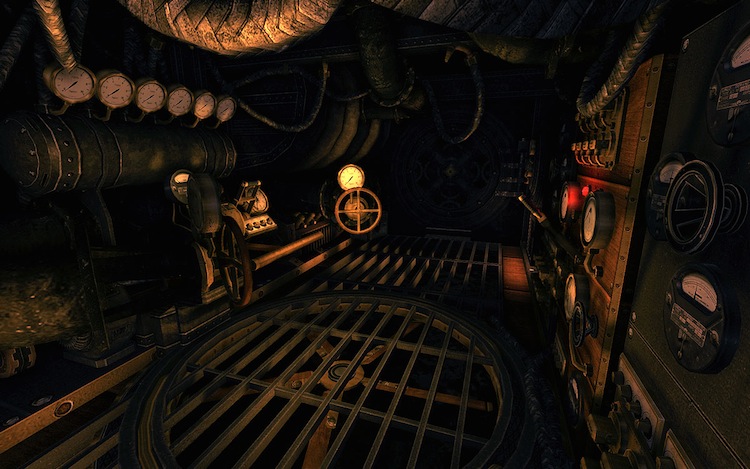From Frictional Games (Amnesia: The Dark Descent) and The Chinese Room (Dear Esther), Amnesia: A Machine for Pigs continues the survival horror Amnesia series with a new story set in 1899.
You play as Oswald Mandus, an industrialist who awakens to an empty house and a rumbling machine that takes the familiar Victorian surroundings to the surreal. Your task? Find out what’s going on.
Gameplay

For players of the previous title, you won’t be going in feeling any comfort from your previous experiences with Amnesia. The exploration of an unnerving landscape will feel familiar, but with a few key elements missing from this iteration, you’ll feel just as helpless as new players.
The biggest change is the lack of an inventory. The developers wanted an experience even The Dark Descent players would feel unfamiliar with. You’ll still have a journal with plot-related notes scattered throughout the game, but you won’t need to collect tinderboxes for light sources or oil for your lantern.
‘The game’s mystery goes beyond what an action horror game like Left 4 Dead brings to the table…’
This also means you won’t be managing your sanity level, for better or worse. As was perhaps expected from teaming up with The Chinese Room, the gameplay shifts more toward narrative, but for certain players – including me – that can be just as terrifying as trying not to pass out from going insane in The Dark Descent.
As with The Dark Descent, A Machine for Pigs requires players to physically interact with doors, drawers, and objects in the environment rather than simply pressing a key. Panic sets in when you’re running away and find yourself trying to push a door that needs you to pull.
Though A Machine for Pigs features many “puzzles” like the previous title, they’re still fairly easy to solve. This isn’t a Myst-level of frustration, but when turning a wheel with grunts and footsteps in the distance becomes a struggle against your own shaking hands, moving a few boxes to find your way through a crawlspace can leave you cowering in the corner just from your own imagination.
And like the previous title, there’s no fighting back. Encountering any of the monsters in the game isn’t meant to be a time for bravery. With “ornamental” rifles displayed on walls throughout the game, you’ll start to wonder why you can’t just fight back. But the game’s mystery goes beyond what an action horror game like Left 4 Dead brings to the table with run-and-gun gameplay.
Graphics
 A Machine for Pigs uses Frictional’s second iteration of their HPL game engine, previously used for The Dark Descent and the first version of which was used in their previous series, Penumbra.
A Machine for Pigs uses Frictional’s second iteration of their HPL game engine, previously used for The Dark Descent and the first version of which was used in their previous series, Penumbra.
The HPL2 engine has been updated, but still shows its age – though it certainly doesn’t detract from the chilling ambiance. Dark, claustrophobic hallways are still creepy and the ornate aura of the Victorian era – just yearning for some steampunk – lends itself to as unnerving of a tone as the first game.
The details are still fantastic. Like the kick up of dust when the wind blew through a hallway in the first game, a sudden jolt from the mysterious machinery jostles chandeliers, throws paintings off the walls, and kicks up dust after everything settles down again.
Sound
Frictional Games’ collaboration with The Chinese Room is perfect for crafting an aural experience that combines the unsettling tone of the previous Amnesia game with the fluid in-game narration from Dear Esther.
Regardless of your thoughts about Dear Esther as strictly a game or an interactive narrative, the style of unfolding plot via seamless voiceovers complements and builds on the similar style of bewildering and unraveling plot from The Dark Descent.
Instead of mini-cutscenes demarcated by white flashes before a voiceover begins, the flashback narration usually cuts in directly over your gameplay, much as it does in Dear Esther. It’s a subtle change, but one that lends itself to a bit more immersion than before.

The ambient sounds are as nerve-wracking during calm periods of gameplay as it is when your in-game character – and you yourself – is panicking. The low rumbling of the world outside the opaque windows follows you as you creep around the house. Just staring into a bath at the beginning of the game made me jump back as the ghostly sound of children playing and unearthly ambient soundtrack kick in.
Like in the previous Amnesia game, stepping into any number of rooms triggers dramatic events seemingly nearby – be it the sound of your son calling for you or some altercation you’ve yet to uncover.
Like in The Dark Descent, the sound design of A Machine for Pigs leaves you hypersensitive to every sound and slight breeze around you. The voiceovers vary from excellent to a bit overwrought, but the aural design of the game is fantastic nonetheless.
Final Thoughts
The raft of reaction videos and (loving) hatred of The Dark Descent will certainly be around for A Machine for Pigs. If you’re looking for a thrill at one in the morning with the lights off and the headphones on, Amnesia: A Machine for Pigs will have you waking up the neighbours in a matter of minutes.
But if you’re anything like me, you’ll probably want to crawl under the bed and cry for a few hours.
How to Get Amnesia: A Machine for Pigs
The game is set to be released tomorrow, September 10, and is currently available for preorder on several platforms, including Steam, Desura, and the Humble Store.
The game retails at $20, £13, and €16.

Amnesia: A Machine for Pigs
Summary
Nightmares? Yes. Fun? Maybe. An experience to miss out on? No.
